
Civil disturbances in Western Australia include race riots, prison riots, and religious conflicts – often Protestant versus Catholic groups.
The Kalgoorlie Miner is a daily newspaper circulating in the City of Kalgoorlie-Boulder and the Goldfields-Esperance region, in Western Australia.
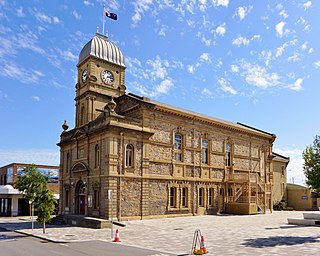
The City of Albany is a local government area in the Great Southern region of Western Australia, about 410 kilometres (255 mi) south-southeast of Perth, the capital of Western Australia. It covers an area of 4,312.3 square kilometres (1,665 sq mi), including the Greater Albany metropolitan area and the Port of Albany, as well as the surrounding agricultural district and some national parks. The City of Albany had a population of over 36,000 at the 2016 census.

Perth Institute of Contemporary Arts (PICA) is a contemporary visual and performance arts venue located in Perth, Western Australia.
Point Heathcote is a geographic feature located on the south east part of Melville Water on Swan River. It is located in Applecross, a suburb of Perth, Western Australia

Boans is the name of a department store that operated in Perth, Western Australia between 1895 and 1986.

The network of railway lines in Western Australia associated with the timber and firewood industries is as old as the mainline railway system of the former Western Australian Government Railways system.
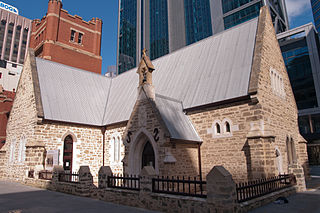
The Old Perth Boys School, located at 139 St Georges Terrace, Perth, Western Australia, is the earliest government school building in Western Australia. The single-storey limestone building was designed by William Ayshford Sanford in 1852 and is a significant example of a colonial building constructed in Perth from the mid-nineteenth century.

The 1910 Perth Technical School building is located at 137 St Georges Terrace, Perth, Western Australia, adjacent to the Old Perth Boys School building, which had served as part of the school's former temporary premises since opening of classes there on 16 May 1900.

The Diocese of Kalgoorlie was a diocese of the Church of England in Australia. It covered much of the Goldfields-Esperance region in Western Australia, and existed from the consecration of its first bishop in 1914 until its re-absorption back into the Anglican Diocese of Perth in 1973. At that point the Kalgoorlie diocese was reported to contain only eight parishes, and was financially unviable as a separate entity.
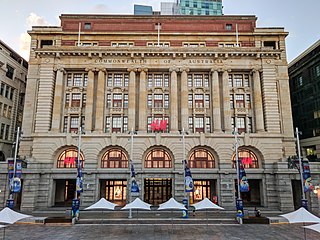
The General Post Office is a heritage landmark building in Perth, Western Australia. Located on the western side of Forrest Place in the city's central business district, its imposing stone facade is in the Beaux-Arts style. The building was completed in 1923 after almost a decade of construction, which was protracted by World War I and the resulting shortages of construction materials. At the time of its opening, it was the largest building in Perth.

The Esplanade Hotel is a hotel located opposite Esplanade Park in Fremantle, Western Australia. The building stands on the site of the first building used for housing convicts transported from Great Britain in 1850.

The Marich Buildings is a single two-storey building at the corner of Henry and High Streets in Fremantle, Western Australia, and dates from c1897; there were several single-storey shops on the site including one occupied by butchers Henry Albert & Co.
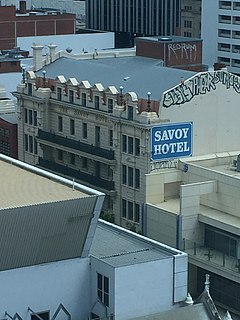
The Savoy Hotel is a heritage-listed former hotel in Hay Street, Perth, Western Australia. It was built in the 1910s and closed in 1991. It is listed on the State Register of Historic Places, has been classified by the National Trust of Australia, and was listed on the former Register of the National Estate.

Trinity Church is one of the oldest church buildings in the City of Perth, and one of the few remaining 19th-century colonial buildings in the city. It is located at 72 St Georges Terrace in Perth, Western Australia.
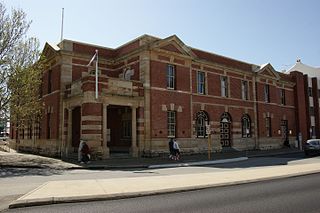
The Old Customs House is a building in Fremantle, Western Australia that was built in 1908 to house the main branch of the Customs Department of Western Australia. It is one of only a handful of extant Customs Houses in the state; others are in Albany, Broome, Cossack, and Geraldton.

Princess Royal Fortress also known as Albany Forts was a fortress on the northern shore of Atatürk entrance on Princess Royal Harbour on Mount Adelaide overlooking King George Sound in Albany, Western Australia. It now operates as a museum.

The Rocks, also referred to as Government House or Government Cottage, is a residence in Albany in the Great Southern region of Western Australia.

Avon Terrace it is the main street of the town of York, Western Australia, and is lined with heritage buildings.
Peter Albany Bell was a caterer and confectioner in Western Australia. He was a significant manufacturer in the state's developing economy.


















